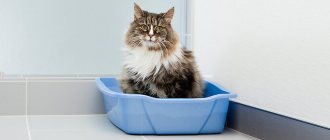In the event that an adult meowing creature appears unplanned in your apartment, as a rule, a huge number of questions arise that must be resolved as quickly as possible. For example, one of them sounds like this: how to train an adult cat to use a litter box?
For many cat owners, the animal’s refusal to use the litter box becomes a significant incentive to achieve their goal.
People often believe that male cats place their scent marks outside the litter box as revenge on their owner. However, this is not always the case. It’s just that, as a rule, in this way the pet “fights” something that worries him. By spreading its scent, which is soothing for it, throughout the house, the animal thereby, as it were, eliminates the imaginary cause of its worries. One of the factors causing anxiety in a pet can be either the mating season (if the cat is not castrated or the cat is sterilized), or an unacceptable atmosphere for the animal in certain places in the apartment. Despite the above, you should not panic if you were unable to solve a household problem the first time - how to train an adult cat to use the litter box.
It is important to choose the right place for your cat to go to the toilet.
Features of training an adult cat
Is it possible to train an adult cat to use a litter box? Of course yes! But let’s immediately agree that you are the owner of the house, not the cat. You are smarter, stronger, you have more opportunities. This means that it is you who bears the responsibility for raising the animal and arranging its living space. The pet is completely dependent on you, which means your task is to place the toilet so that it is convenient for the pet to go to it. To do this, you will have to be patient and not wait for quick results.
If you are adopting an adult domestic cat, be sure to ask where his litter box was, what it looked like, and what kind of litter was used. You can ask the owners for an old tray for the first time - the cat knows it and knows why it is needed. Buy the same filler. Try to reproduce the environment your cat is familiar with at home. This way the animal will be less stressed, and it will immediately figure out where to “do things.”
When the cat gets used to the house, you can buy a new tray and, if necessary, gradually retrain it to a new placement, for example, not in the hallway, but in the bathroom or toilet. At the same time, you should limit access to undesirable places and hide things that your pet “encroaches” on: close the door to the bedroom, cover your favorite chair with oilcloth, hide slippers or other shoes, tightly close the cabinet with bed linen, blankets, etc.
With street cats the situation is more complicated. You know practically nothing about the animal and its habits. How long does it take to litter train an adult outdoor cat? In each case, it depends on you and the cat, that is, strictly individually. Some pets understand where to go to the toilet from the first hours in their new home, while others need weeks to figure it out. Therefore, you will have to be patient and empirically search for a toilet option that suits you and your pet.
An adult cat's character has already been formed, so you will have to be creative to achieve the desired result. No aggression! No screaming and, especially, no physical punishment! Only affection and patience will help your cat develop the skill you need.
How to toilet train an adult street cat is not an easy question. Typically, animals taken from the street find any quiet corner suitable for satisfying their natural needs. And if you scold the animal, it will look for more and more secluded corners. Each time, searching for and cleaning up the “consequences” will become more and more tedious. Therefore, it is worth asking the question: how to accustom a cat to an adult litter box - without stress and forever.
There are a number of factors to take into account here:
- type and size of the tray;
- filler;
- the place where the toilet is located;
- character traits of the animal.
What to do if you catch a kitten in flagrante delicto
At the moment when you see a puddle on the floor or on the sofa, you should not give in to aggression. Yes, an unpleasant sight. But with your screaming or assault, you will only frighten the little kitten even more.
First of all, you need to force yourself to calm down. In this case, you can dip a napkin in the puddle and put it in the tray, then place the kitten in it. The baby must understand that he needs to go to the toilet here. It would be good to rinse the “wet area” with water and strong-smelling disinfectants.
How to choose a tray and filler
If you are adopting an adult domestic cat from other owners, you can ask for a litter box. And if this is not possible, then ask what kind of toilet the cat had and what kind of litter the previous owners used. And at the same time, find out if your pet has a habit of marking the territory outside the toilet. If precedents have occurred, you may want to try a different filler.
Experience shows that you can accustom a cat to the litter box of an adult from the street quite quickly if you choose the right litter box and litter. Typically, such pets prefer wood or bentonite (clay) filler, as well as sand. They have a natural smell and are perceived by cats as more familiar and understandable. But scented fillers or silica gel rustling under the paws can scare away the animal.
The granules must be of the optimal size. Such that it doesn’t put pressure on the cat’s paws and doesn’t make it difficult for him to move in the litter box. If a small kitten or a cat with problems with its paws is given large granules that cause discomfort, the animal will most likely stop going to the litter box until the filler is changed to a more comfortable one.
The tray should be high enough, with sides at least 10 cm high, so that when burying excrement, the cat does not scatter the litter on the floor. To avoid unnecessary cleaning, you can buy a cat litter with a frame. But keep in mind that high sides can be a problem for kittens and small cats. The problem can be solved if you purchase a tray with one low edge, which will be comfortable for even a small kitten to step over.
It is easier to train an adult cat to use a litter box if the tray is the right size. A large animal that requires a lot of space in the toilet will simply ignore a small tray.
The question: how to accustom an adult cat to a litter box without litter arises most often when the cat manages to pour almost all of the litter onto the floor in the process of burying secretions. How to accustom an adult cat to a litter box with a mesh?
You should begin the process of “relocating” to a tray with a mesh only after the cat consistently goes to the toilet in the designated place. Then you can gradually reduce the amount of filler, and then replace it with newspaper or pieces of toilet paper. The animal will get used to the absence of filler, and then you can offer it a tray with a mesh. For the best effect, we recommend treating the new tray with a toilet training product, which can be purchased at pet stores and veterinary pharmacies.
Kitten training
As a rule, the kitten wants to go to the toilet after the next meal, active games, or after waking up. Based on your baby's behavior, you will understand that he wants to go to the toilet:
- restless movements;
- trampling on the spot;
- sniffing the floor and other objects;
- scraping a paw along the floor.
When you notice such actions, take the initiative into your own hands. Without scaring the cat, pick it up, bring it to the installed tray, and place it there. If the animal breaks out, do not force it to sit down, do not hold it by the paws, otherwise the kitten will associate the new toilet with torture. It is better to act with affection and tenderness. Pet the kitten. Talk to him softly and calmly.
Then take one of its paws and dig into the litter. The kitten's instinct will awaken and it will go to the toilet. Usually kids grasp everything quickly. Once or twice is enough and the kitten will understand that the tray is the place for his toilet . If suddenly an animal goes near the tray, do not scold or hit the baby. Attempt number 2 or 3 will be more successful.
© shutterstock
Dampen the wet area with a napkin or toilet paper and leave it in the tray with litter, or collect solid excrement and place it in the litter.
The next time the animal hears its native smell and goes to where its former feces are located. And wash the area “past the tray” with disinfectants to remove the smell. Good help in this situation:
- Ammonia.
- Regular or apple cider vinegar.
- Soda.
- Bleaching.
- Citrus juice.
- Repellent spray.
How to train a cat to use a litter box
Adult cats need to be trained to use the litter box gradually. First, show the animal the tray, rustle with the litter, let it sniff and examine it. It is advisable to place the tray in a quiet corner, since cats are “embarrassed” to go to the toilet in plain sight; they need a quiet, comfortable place. A bathroom or toilet room or a corner of the corridor are perfect.
If your pet likes the place, he will start using the toilet from the first day, and you will not have any problems. But you’re not always so lucky; often the cat shits in places other than where you suggest it. How to proceed in this case?
You need to collect excrement with a napkin or spatula, transfer it to a tray, put it in it and show it to the animal. You can even try to “bury” them with his paw.
Secondly, the “wrong” place must be thoroughly washed with a special detergent, treated with a spray to wean cats off the toilet, or rubbed with lemon or orange peel. Animals do not like this smell and will avoid this corner. Thirdly, you can completely stop access to an unwanted place: close the door to the room, temporarily put some furniture in the corner.
Another option is to place the tray in the corner where the cat goes to relieve himself, and when he gets used to the tray, gradually move it to the place you need and praise and treat your pet with treats for a successful “visit” to the toilet. Positive motivation usually works very well with these smart animals.
If your cat stubbornly refuses to go to the toilet, observe her behavior. The pet definitely doesn’t do this “out of spite”; he has his own reasons for ignoring the tray. Your task is to figure out what's going on.
There can be many reasons:
- puberty or period of sexual arousal;
- disease, most often of the bladder or kidneys;
- the appearance of another cat or other pet in the house;
- unpleasant filler or odor in the place where the toilet is located.
In this case, you need to act according to the circumstances: take the animal to the veterinarians, sterilize it, buy another filler or air freshener, etc.
Some Caveats
The kitten should be seen by a doctor.
A complete examination will allow you to exclude the presence of diseases in the animal that can cause problems in the process of accustoming the animal to the tray. Kittens should be fed only wet and dry food , which is intended only for them. You should not buy formulations intended for adults. This can cause digestive upset in the kitten, leading to undesirable consequences.
There are situations when kittens deliberately do not go to the litter box to relieve themselves, because the owner severely punished him for incorrectly removing the place. The animal may simply be afraid of its toilet. They especially do not like trays located in a visible place. It is better to place the container in a more modest corner. Under no circumstances should you severely punish an offending cat. This will only make the situation worse.
Is it worth punishing if the cat does not go to the litter box?
If the question of how to accustom an adult cat to a litter box in a new home is not resolved immediately, shouting or resorting to physical punishment is not only unnecessary, but also harmful. Cats are excellent at distinguishing intonation, and your dissatisfied voice will be a signal that “something is wrong.” The animal will be offended by shouting or beating and will deliberately spoil your things.
Moreover, in order to hide the Skoda, the cat will begin to look for more and more inaccessible and hidden places. As a result, the smell will spread throughout the house, and it will become more and more difficult for you to find its source each time. The cat will have negative associations with the litter box, and it will be even more difficult to train your pet to use it.
Don’t be lazy each time to explain to your pet what is required, take the excrement to the tray and bury it. You can even try burying the waste with your pet’s paw, and then praise it and treat it to something tasty. Usually, after 3-5 repetitions of this procedure, cats themselves begin to run around the house at the right moment in search of the “right” place for the toilet.
If the cat periodically “does not get” to the intended place, it is worth showing it to a veterinarian. Perhaps the animal has pain in the kidneys or genitourinary organs.
To each his own
First of all, all owners who want to accustom their pet to a civilized trip to the toilet should remember that helping a kitten and an adult animal need to be done differently. The only similarity between them is that the tray is something new and unknown for them. Therefore, it will take time for the cat to understand where the new place is now to relieve itself. And you, as the owner, must take on the role of a patient teacher in this difficult matter.
Usually, if an animal once went to the wrong place, then the next time there is a high probability that it will go to the same place.
Why? Because the cat found the designated place for the toilet by smell (in her opinion). And if at this turning point you do not begin to accustom the cat to the new rules, it will subsequently be very difficult to retrain the cat. Start your training with three important points.
© shutterstock
How to stop an adult cat from shitting
To protect your home and furniture from being “mined” by your cat, experts recommend starting with studying the animal’s health. He may need to be treated. If the cause of the marks is hormonal activity, it is recommended to sterilize the pet.
Uncontrollable urination can be caused by diseases, including infectious diseases caused by flea bites and other parasites. Therefore, take care of hygiene and regularly wash your pet with special shampoos, wear an anti-parasitic collar and be sure to treat it with a spray or other insecticidal preparations during the insect active season.
It is also recommended to take the following measures:
- make it difficult or completely block access to an unwanted toilet area;
- provide free access to the tray;
- wash the unwanted area with detergents and treat it with a special spray or citrus essential oil, and treat the tray with a spray that attracts the animal’s attention;
- praise, stroke and pamper with delicious food every time the cat visits the tray;
- try several litters and buy only the one that your cat likes: so that it absorbs moisture and odors and does not cause discomfort.
Location is key
Location, location, location! What is said about real estate also applies to the cat litter box: its proper position can make the transition to a new litter box easier.
Moving the litter box to a new location can be confusing for your cat, especially if it is not the same box she is used to. Consider placing the new tray exactly where the old one was. This will help her understand that the new box performs the same functions as the old one.
© shutterstock
If you use the same litter and the same type of litter box, your cat probably won't mind. If you're switching to a different style of litter box, such as self-cleaning or covered, keeping it in one place can limit the shock of the change.
However, if you do want to change locations, leave the old litter box in place during the transition. Try to make your new box more desirable by cleaning it often. Hopefully your cat will realize the benefits of using a new box and stop using the old one on its own.
Veterinarian advice
- Try to choose a tray with a larger area and low sides. This is the most convenient tray for kittens. A grown animal may simply not fit into a small tray.
- For the tray, it is better to choose a calm, quiet place where there are not many people;
- If your pet likes to dig into the litter, you can consider the option of a closed tray. In this case, the litter will not be scattered throughout the room, and the smell from the cat litter will be less. In addition, in a closed space the cat feels calmer and more private.
- The tray must be changed as needed. If it is a natural filler - at least once every 5 days, if silica gel - once every 3 weeks. The tray itself must be washed with water and cleaning agents.
- Make sure that the layer of filler in the toilet is at least 5 cm.
- It is best if the cat's litter box is placed on a special mat. In this case, the cat will have the opportunity to wet its paws after using the toilet, which will significantly increase the cleanliness of the house.
- For kittens up to 8 months, it is better to choose litter with natural ingredients.
- If your pet refuses the litter box and shits in the apartment, you should show it to the veterinarian; perhaps this is how the cat signals existing health problems.
Cats are sweet, kind and caring creatures that bring comfort and joy to your home. Taming them sometimes seems like a difficult task. But if you know the simple methods and rules, this activity will not take you much time, and in the end you will only get positive emotions from communicating with your pet and a clean apartment. Go for it, you will succeed!
By the way, there is another option - you can use a toilet as a toilet. Details in this video:











